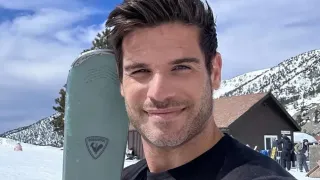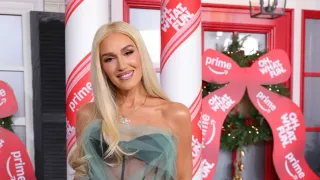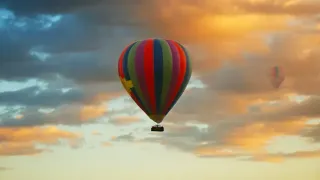October 30, 2019
'Alive in the Moment' – Playwright Korde Arrington Tuttle talks Robert Mapplethorpe and 'Triptych'
Robert Nesti READ TIME: 12 MIN.
In 1970 Robert Mapplethorpe bought a Polaroid camera to take photos he would use in his colleagues. Over the next 19 years – until his death from AIDS in 1989 – he brought a rigorous formalism to his subjects, from his studies of flowers and celebrity portraiture to his explicit homoerotic photos that would immerse him in controversy during his final days.
The battle over those photos in 1989, which Mapplethorpe included in a traveling show called "The Perfect Moment," was one of the crucial battles in the culture wars at the end of the Reagan era. The show had received funding from the National Endowment for the Arts, which immediately put it in the crosshairs of the Religious Right, who condemned public funding of a show that featured explicit sadomasochistic images, including one of the artists with a bullwhip inserted in his anus. In Washington, the Corcoran Gallery of Art canceled the exhibit; in Cincinnati, the show opened, only to have Contemporary Arts Center and its curator arrested on obscenity charges. (They were dismissed.)
Bryce Dessner, composer and member of the indie group The Nationals, was a 14-year old teen growing up in Cincinnati at the time and the incident awoke him to the issues surrounding censorship and the arts. "It was like a bomb went off in the city," he told The Boston Globe last week. "I'd been a Reagan-era kid, largely oblivious to the culture wars, and even to some of the politics," he says. "It was an educational moment, and a real tricky moment for the city that still is, actually."
Now some 30 years later, Dessner returns to Mapplethorpe for "Triptych (Eyes of One on Another)," a new musical theater piece that explores the legacy of Mapplethorpe's art in the 21st century for which he composed the score. ArtsEmerson and the Celebrity Series of Boston bring the piece to Boston from October 30 through November 3 at Cutler Majestic Theatre. For more information, The piece utilizes a fusion of disciplines - images of Mapplethorpe" s="" works="" are="" projected="" on="" a="" screen="" on="" the="" rear="" of="" the="" stage;="" a="" nine-piece="" chamber="" orchestra="" and="" the="" vocal="" ensemble="" Roomful="" of="" Teeth="" play="" Dessner's="" music;="" along="" with="" a="" solo="" male="" dancer.="" This="" all="" plays="" with="" a="" libretto="" by="" playwright=""
The texts "do evoke the brew of objectification, glorification, aggression, submission, risk and reward in Mapplethorpe's photographs, particularly those of black men," wrote New York Times critic Zachary Woolfe in reviewing a concert version of the work in Los Angeles earlier this year. "The words are not always easy on the artist; they draw an uncomfortable parallel between different meanings of 'shooting' someone, and, in one section constructed as a dialogue, suggest Mapplethorpe exploited his models."
Tuttle came to the piece midway through development, as he explains in the following interview. He was at the Goodman Theatre in Chicago for a production meeting for his latest play, "Graveyard Shift," that premieres there in January. Amongst his numerous achievements, Korde is a current playwright-in-residence at Lincoln Center Theater, a Resident Artist at Ars Nova, and is a Middle Voice Theatre Company member at Rattlestick Playwright's Theater.
Starting over from scratch
An incredible artist
EDGE: Does it stay with us because the images remain provocative or because of his skills as an artist?
Korde Arrington Tuttle: I think his skill as an artist – that is not a question in my mind. He is an incredible artist, but that aside, the questions that come up around consent, around power and control, around intimacy, race, sexuality and violence. I think the things that he captured are things that we are still culturally uncomfortable with. I think he having those conversations visually, aesthetically, but also doing it so well, so beautifully. So I think the ingredient of beauty and a kind of clarity of vision allows that work to continue to rise to the task.
EDGE: You mentioned how you were drawn to Mapplethorpe while in college. Was it his outlaw persona that you responded to?
Korde Arrington Tuttle: That was an aspect of the work that I did respond to. I found that transgressive in ways that were exciting to me. I think I found what he was capable of and how he lived his life was something I did not feel I had access to. It was not modeled for me. I did not have those models around me in thinking about ways to live a life of making a life as an artist, especially a gay artist. But the work for me was as great a provocation as the actual persona and lifestyle.
EDGE: You grew up in a very conservative and religious household. White neighborhoods? How did you grow to find your identities – as a black, gay man – in that constricted atmosphere?
Korde Arrington Tuttle: I would say that the uncovering of my identities, the deepening of my identities, came in building relationships. In my actively seeking out communities, seeking out relationships, seeking out spaces, seeking out opportunities where I could go into myself. One was teachers that I had in high school who pushed me towards poetry, towards certain artists before I got to college and could do it on my own. I had to find it wherever I could.
One of the things that really changed the trajectory of my life was participation in a conference that is called the Student Diversity Leadership Conference, which falls under the umbrella of the National Association of Independent Schools. I attended that conference in high school and for the first time, I was surrounded by hundreds of other young people who identified across the gender spectrum, across the sexuality spectrum. Multiracial, multicultural. Who were also coming from environments like one – largely conservatives environments like mine – who were able to come and have conversations about what it means to be. To unpack our identities in these conversations. I went back as a facilitator in high school and after high school, I worked at that space. I think I also found that space in theater. I found that space in athletics. I found that with like-minded people.
The ways he saw the world
EDGE: You have spoken of how while in high school you underwent conversion therapy. How wouldEDGE: You have spoken of how while in high school you underwent conversion therapy. How would you describe that experience? Rather how it relates to you developing as a gay artist? How were you able to emerge for it?
Korde Arrington Tuttle: I am not sure I have an answer outside of having a resiliency. But I don't know where that came from. Just an inner knowing that the situations I found myself in were not the end for me. I certainly think it informs my relationship to writing and playwriting in thinking about silence, and being silence, thinking about censorship, thinking about having such cleans lines drawn around my behavior and identity. And thinking about the consequences. The consequences of being myself and things that felt very natural to me were policed and punished. I think that writing for me became a way to have conversations in private ways that would become public when there was freedom around that. It certainly has informed my artistry in the way I move through the world. I am not sure. It was a very large experience. I don't know how to minimize that.
EDGE: When you went to the archives, what surprised you about Robert Mapplethorpe?
Korde Arrington Tuttle: I was deeply moved by getting to see and meditate on all the ways Robert saw the world. There was an intimacy to the work when it was just me and all the photos, me and the archive. There was a tenderness that presented itself to me that sat outside the kind – of austerity that is sometimes expressed in gallery spaces. There was a thinking about his spending time with and his interactions with certain models over time, or in a variety of moments ... a different kind of consent, a different kind of trust. I had not really spent a lot of time outside of flowers and Robert's shooting florals, still-lifes and nature and women and architecture. There was a whole world, another side I was not really aware of. you describe that experience? Rather how it relates to you developing as a gay artist? How were you able to emerge for it?
Korde Arrington Tuttle: I am not sure I have an answer outside of having a resiliency. But I don't know where that came from. Just an inner knowing that the situations I found myself in were not the end for me. I certainly think it informs my relationship to writing and playwriting in thinking about silence, and being silence, thinking about censorship, thinking about having such cleans lines drawn around my behavior and identity. And thinking about the consequences. The consequences of being myself and things that felt very natural to me were policed and punished. I think that writing for me became a way to have conversations in private ways that would become public when there was freedom around that. It certainly has informed my artistry in the way I move through the world. I am not sure. It was a very large experience. I don't know how to minimize that.
EDGE: When you went to the archives, what surprised you about Robert Mapplethorpe?
Korde Arrington Tuttle: I was deeply moved by getting to see and meditate on all the ways Robert saw the world. There was an intimacy to the work when it was just me and all the photos, me and the archive. There was a tenderness that presented itself to me that sat outside the kind – of austerity that is sometimes expressed in gallery spaces. There was a thinking about his spending time with and his interactions with certain models over time, or in a variety of moments ... a different kind of consent, a different kind of trust. I had not really spent a lot of time outside of flowers and Robert's shooting florals, still-lifes and nature and women and architecture. There was a whole world, an other side I was not really aware of.
Issues of consent
EDGE: Do you have ambivalence toward his work, by that I mean an admiration of it while simultaneously being critical of it?
Korde Arrington Tuttle: I think I allow multiple points of view, multiple feelings can co-exist. I don't think anything is ever one thing. At the same time, I can think about consent and intimacy, especially between Robert and some of his black models, to me that does not contradict conversations about exploitation. Or the ways in which racialized violence or the white gaze is also present at the same time. So I think that allowing all those things to coexist, there is a combustible nature to the work that not only continues to make it relevant, but also excites me because I think that complexity, and having conversations about complexity, can move culture forward and allow us to have more substantive, meaningful conversations about art, about life, about culture, and in my experience, deepens my relationship with being human.
EDGE: You chose to use the words of poet Essex Hemphill in your piece. Why is that?
Korde Arrington Tuttle: Essex was critical of Robert and his work and wrote a piece that was directly addressed to Robert in questioning whether aesthetics can justify desire. For me, that is a conversation we are having now. It could have been written today. So I feel as though Essex is an incredible artist in his own right and lived a life that embodied what it means to sit on the other side of Mapplethorpe's lens. Both Bryce and I thought that was a conversation worthy of having now and not one we have had or seen about Robert's work. And second, the opportunity to humanize the models and have a conversation about race in a dramatic way – a way that engages not just politics and culture, but has it in a beautiful way and gets to engage beauty through poetry, through music, through the visual landscape. This is what we wanted to explore in the piece.
"Triptych (Eyes of One on Another)" plays October 30 through November 3 at Cutler Majestic Theatre, 219 Tremont Street, Boston, MA. For more information, the ArtsEmerson website.






